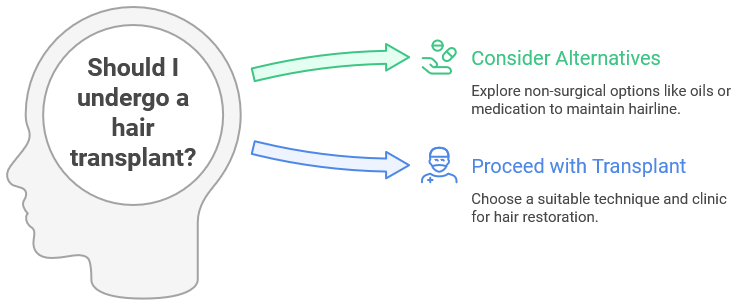Modern technology has made hair restoration incredibly safe and reliable. However, this is still a medical procedure, which means that there is always some risk involved. It all depends on the clinic, with the skill and experience of the team playing a big role in how things turn out, and the method used.
We will go over the most important details and things to look out for, so you can have peace of mind when you decide to go ahead with a transplant.
Did you know?
The ISHRS 2025 Practice Census reports that in 2024, ISHRS member physicians performed an average of 15 hair restoration surgeries per month, reflecting their highly hands-on and expert approach to these procedures.”
Why is a Good Consultation for Hair Transplant Surgery Important?
First of all, you will need to talk to a qualified professional about which technique would suit you best and what the associated risks are. For example, the older Follicular Unit Strip Surgery (FUSS) involves cutting a piece of tissue from the back of the head. That increases the risk of potential infection compared to more modern techniques with minimal tissue damage.

Who is a Good Candidate for Hair Transplant Surgery
As long as you are in good overall health, with normal blood pressure and no serious medical conditions, you can expect excellent hair growth. However, you must also have plenty of available follicles in the donor area and be over 30 years old, so that your specific pattern and rate of hair loss become apparent.
It’s also a good idea to try out other treatments like argan and rosemary oil, or medication like Minoxidil and Finasteride, if you only have a slightly receding hairline, to see if it can be maintained without an operation. If nothing else seems to be working, and the bald spots are growing, then it is time for a long term solution.
What are the Risks Involved?
As we’ve briefly mentioned, different hair transplant procedures will have different potential side effects, so we will look at what you can expect with either FUSS, more commonly called Follicular Unit Transplantation (FUT) or the more popular in recent years Follicular Unit Extraction (FUE).
Here is a quick comparison based on the latest findings and the opinions of experienced surgeons with thousands of operations under their belt.
What Are the Signs of Hair Transplants Gone Wrong?
There are several complications that can occur, which are a clear sign that the operation wasn’t a success:
- Awkward or patchy growth: Improper implantation or a low graft survival rate due to poor handling can cause the new hair to be thicker in some areas and thinner or nonexistent in others
- Weird hairline: Really sharp angles, completely straight, or too low of a hairline are all indicative of a hastily planned procedure where the patient’s natural features were not taken into account.
- Significant scarring: Tiny, barely noticeable circular scars around the base of the hair are normal, but if there are larger scars that can be seen from further away, something has gone wrong.
- Profuse bleeding: A small amount of bleeding from the transplanted hair during the first couple of days is to be expected, but if there is a lot or it persists for longer, it is a problem.
- Excessive swelling and pus: These are typical signs of an infection, and you need to be treated with antibiotics as soon as possible.
Keep an eye out for any of these issues. Although they are rare, some of them could lead to more serious problems.
When to Call a Doctor?
As long as you visit a reputable clinic for a hair transplant in Turkey, the risk of complications should be minimal, and the recipient area will fully heal over the course of two weeks. However, if you notice some of the more serious issues, like your hair grafts becoming inflamed or bleeding a lot, or if you are not healing as fast as expected, then you should definitely contact a doctor for advice.
FAQs
How long does it take to recover from a hair transplant?
It will usually take 4–5 days for most of the swelling to go down, and the pain to stop, and around 14 days for your donor hair follicles to take root and heal completely. All the scabs should fall off on their own by this time, and you will be able to return to your normal routine and wear any type of hat or helmet.
Can the results look unnatural?
If done improperly by an inexperienced doctor, then yes. That’s why you should always look for reputable clinics with good reviews and plenty of before-and-after pictures of real patients.
Is hair shedding after a transplant normal?
About a month after the operation, the hair will enter its resting phase and shed, which is normal. However, if there is a lot of shedding within a week or two, this is a sign that something is wrong.
Do these procedures cause permanent scarring?
Modern procedures leave tiny scars that are only visible upon close inspection and easily covered up by your existing hair, while the old FUT technique leaves a long linear scar at the back of the head.
